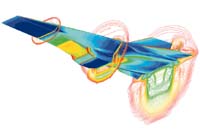| . |  |
. |
 NASA Seeks Ideas For Future Space Transportation Plan
NASA Seeks Ideas For Future Space Transportation PlanHuntsville - March 20, 2000 - NASA is beginning a new journey toward the launchpad with a second-generation reusable launch vehicle (RLV) system that will be safer and cheaper than today's technology, and will rely more heavily on the commercial space business to meet NASA's science and exploration goals. The agency Tuesday published a NASA Research Announcement entitled "Second Generation RLV Risk Reduction Definition Program." It calls for industry proposals as a first step in defining detailed requirements, and identifying and commencing initial risk reduction options, to enable a second-generation Reusable Launch Vehicle competition in 2005, leading to an operational system around 2010. The studies will serve as a springboard for the five-year, $4.5 billion effort to reduce the risk associated with building and operating next-generation launch systems before entering the full-scale development phase in 2005. "In the last several years, NASA has initiated several technology demonstration programs," said Dr. Row Rogacki, director of the Space Transportation Directorate at NASA's Marshall Space Flight Center in Huntsville, Ala. "We've invested in specific concepts. We've partnered heavily with industry on aggressive technology programs. We've made great progress and gained much insight into promising emerging technologies. We better understand the balance between commercial and government interests. "However, NASA has encountered difficult lessons and delays in key technology projects," Rogacki said. "We've learned that more development along multiple competing paths is needed. We've learned that commercial markets are not growing as previously projected. "But there are still possibilities to make access to space more robust," he said. "This effort is part of the Administration's Space Launch Initiative intended to target these challenges."
NASA's strategy has three main goals:
The risk reduction program will be a NASA-wide effort and also will involve the U.S. Department of Defense. A briefing for potential bidders will be held March 10 at 9 a.m. CDT at the Marshall Center in Building 4200, in Morris Auditorium. Industry proposals in various technical areas are due by June 1. NASA anticipates multiple awards this year resulting from the NASA Research Announcement. The risk reduction program is a result of NASA's industry-led Space Transportation Architecture Studies in 1998 and 1999, and the agency's Integrated Space Transportation Plan developed in the fall of 1999. In addition to a second-generation reusable launch vehicle, that plan addressed safety upgrades for the Space Shuttle, a crew return vehicle for the Space Station and basic technology research. Those elements are covered in other program plans.
RLV ALERT
|
| |||||||||
| The content herein, unless otherwise known to be public domain, are Copyright 1995-2016 - Space Media Network. All websites are published in Australia and are solely subject to Australian law and governed by Fair Use principals for news reporting and research purposes. AFP, UPI and IANS news wire stories are copyright Agence France-Presse, United Press International and Indo-Asia News Service. ESA news reports are copyright European Space Agency. All NASA sourced material is public domain. Additional copyrights may apply in whole or part to other bona fide parties. Advertising does not imply endorsement, agreement or approval of any opinions, statements or information provided by Space Media Network on any Web page published or hosted by Space Media Network. Privacy Statement All images and articles appearing on Space Media Network have been edited or digitally altered in some way. Any requests to remove copyright material will be acted upon in a timely and appropriate manner. Any attempt to extort money from Space Media Network will be ignored and reported to Australian Law Enforcement Agencies as a potential case of financial fraud involving the use of a telephonic carriage device or postal service. |